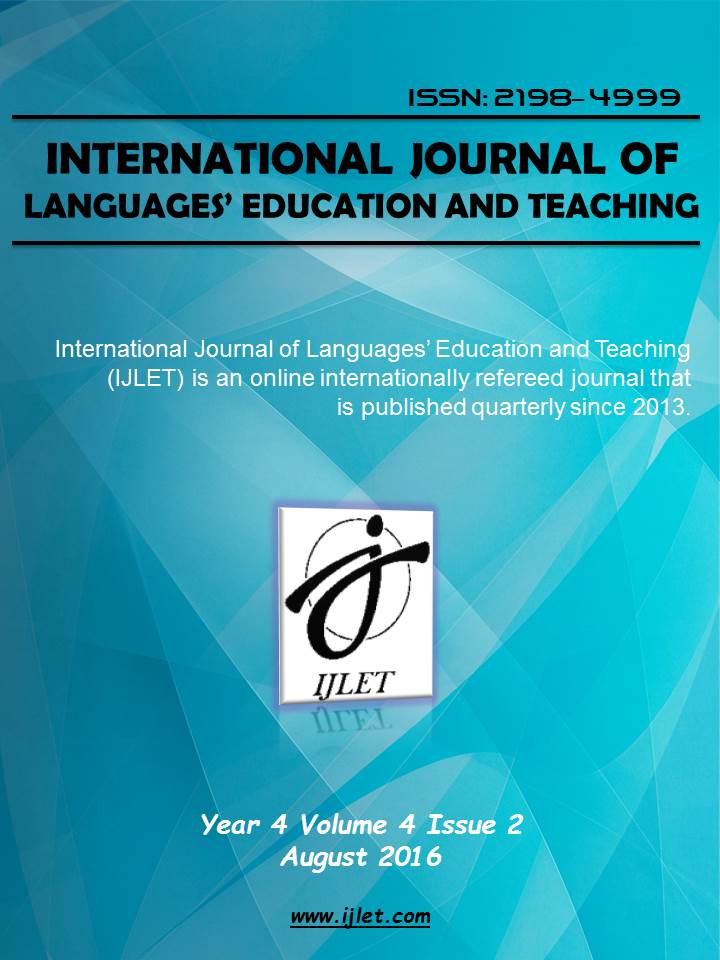Author :
Abstract
Günümüzde, altyazı çevirisi, çeviribilim lisans eğitiminde önemli bir ders olarak yerini almıştır. Çalışmada, altyazı çevirisi dersinin, çağdaş eğitim ilkeleri ve uygulamaları sayesinde, teknoloji ile bütünleşik ve çeviribilim mezunu olan öğrencinin piyasada bu alanda iş bulabileceği nitelikte yetişmesine uygun olarak düzenlenmesi ve verilmesi konusu ele alınmıştır. Çağdaş çeviri eğitimi ilkeleri ve altyazı çevirisinin temellerine ilişkin kuramsal bir tanıtımın ardından, altyazı çevirisine özgü düşünme şekli, öğrencilerin edinmesi gereken edinç ve beceriler örneklenerek ve gerekçelendirilerek açıklanmıştır. Altyazı çeviri dersinde edinç ve beceri geliştirimine yönelik olarak tasarlanacak beş bileşenli bir eğitimin içeriği anlatılmış, bunun ardından bazı alıştırma ve uygulamalar önerilmiş ve örneklenmiştir. Son olarak, altyazı çevirisinde ölçme ve değerlendirme konusu ele alınmıştır. Çağdaş eğitim yaklaşımlarıyla teknolojinin yanı sıra, altyazı çevirisi eğitimine özgü özellikler göz önünde bulundurularak, bir eğitim modeli oluşturulmuştur. Söz konusu taslak model, bu konuda ders verecek olan meslektaşların üzerinde düşünebilecekleri bir öneri niteliğindedir.
Keywords
Abstract
Subtitling is one of the important courses in contemporary undergraduate translator training. The study deals with the preparation and delivery of a subtitling course, in view of contemporary training principles and practices, in a way that it is integrated with technology and for the purpose of training professionally proficient graduates. Following a theoretical background on the principles of contemporary training practices and the fundamentals of subtitling training, the way of thinking to be instilled in the future subtitler, the skills and competences that students need to acquire have been exemplified and detailed. The content and flow of a model for such training composed of five training modules has been provided along with examples of some exercices and practices. Finally, the study refers to the issue of evaluation and grading in the subtitling classroom. The training model proposed takes into account new training practices, technology and the specifics of subtitling training. The model is proposed as food for thought for those colleagues undertaking subtitling training at the undergraduate level at universities.
Keywords
- Banos, R. Ve S. Bruti ve S. Zanotti. 2013. Corpus linguistics and Audiovisiual Translation: in search of an integrated approach. Perspectives, 21:4, 483-490. DOI: 10.1080/0907676X.2013.831926. http://dx.doi.org/10.1080/0907676X.2013.831926.
- Bartina, F ve E. Espaca. 2005. Audiovisual Translation. Training for the New Millenium. M. Tennant (Ed.). Amsterdam: John Benjamins. 83-100.
- Borodo, M. 2015. Multimodality, translation and comics. Perspectives, 23:1, 22-41. DOI: 10.1080/0907676X.2013.876057. http://dx.doi.org/10.1080/0907676X.2013.876057.
- Calvo, E. 2015. Scaffolding translation skills through situated training approaches: progressive and reflective methods. The Interpreter and Translator Trainer, 9:3, 306-322. DOI: 10.1080/1750399X.2015.1103107. http:// dx.doi.org/10.1080/1750399X.2015.1103107.
- Diaz Cintas, J. ve P. Orero. 2003.Postgraduate Courses in Audiovisual Translation, The Translator, 9:2, 371-388. DOI: 10.1080/13556509.2003.10799164. http://dx.doi.org/10.1080/13556509.2003.10799164.
- Diaz-Cintas, J. ve A. Remael. 2007. Audiovisual Translation: Subtitling. Manchester: St. Jerome.
- Dorado, C. ve P. Orero. 2007. Teaching Audiovisual Translation Online: A Partial Achievement. Perspectives, 15:3, 191-202. http: dx.doi.org/10.1080/13670050802153988.
- Fernandez, F. ve P. Zabalbeascoa. 2012. Correlating trainees’ translating performance with the quality of their metacognitive self-evaluation. Perspectives, 20:4, 463-478. DOI: 10.1080/0907676X.2011.629730.
- Flanagan, M. ve T. Paulsen Christensen. Testing post-editing guidelines: how translation trainees interpret them and how to tailor them for translator training purposes. The Interpreter and Translator Trainer, 8:2, 257-275. DOI: 10.1080/1750399X.2014.936111.
- Galan-Manas, A. ve A. Hurtado Albir. 2015. Competence assessment procedures in translating training. The Interpreter and Translator Trainer, 9:1, 63-82. DOI: 10.1080/1750399X.2015.1010358. http://dx.do.org/ 10.1080/1750399X.2015.1010358.
- Gallego-Hernandez, D. 2015. The use of corpora as translation resources: A study based on a survey of Spanish professional translators. Perspectives, 23:3, 375-391. DOI: 10.1080/0907676X.2014.964269. http://dx.doi.org/10.1080/0907676X.2014.964269.
- Hurtado Albir, A. 2007. Competence based curriculum design for training Translators. The Interpreter and Translator Trainer, 1:2, 163-195. DOI:10.1080/1750399X.2007.10798757. http://dx.doi.org/10.1080/1750399X.2007.10798757.
- Kajser-Wietrzny ve M. Tymczynska. 2015. Devising a systemic approach to examination marking criteria for audiovisual translation: a case study from Poland. The Interpreter and Translator Trainer, 9:3, 342-355. DOI:10.1080/1750399X.2015.1100400.
- Kelly, D. 2005. A Handbook for Translator Trainers. Manchester: St. Jerome.
- Kiraly, D. 2000. A Social Constructivist Approach to Translator Education. Manchester: St. Jerome.
- Kiraly, D. 2012. Growing a Project-Based Translation Pedagogy: A Fractal Perspective. Meta, 57 (1), 82-95. DOI: 10.7202/1012742ar.
- Koscialkowska-Okonska, E. 2015. Teaching translation: How to make it more effective for our students? Lodz Studies in Language 39, Constructing Translation Competence, P. Pietrzak ve M. Deckert (Ed.). Frankfurt am Main: Peter Lang Edition. 49-62.
- Lasnier, F.2000. Réussir la formation par compétences. Montreal: Guérin.
- Lederer, M. 2007. Can Theory Help Translator and Interpreter Trainers and Trainees? The Interpreter and Translator Trainer, 1:1, 15-35. DOI: 10.1080/1750399X.2007.10798748.
- Li, D. 2011.Think aloud teahcing in translation class: impilcations from TAP’s translation research. Perspectives: Studies in Translatology, 19:2, 109-122. DOI: 10.1080/0907676X.2010.506955.
- Li, D. ve C. Zhang ve Y. He. 2015. Project-based learning in teaching translation: students’ perceptions. The Interpreter and Translator Trainer, 9:1, 1-19. DOI: 10.1080/1750399X.2015.1010357.
- Massey, G. ve P. Jud ve M. Ehrensberger-Dow. 2015. Building competence and bridges. Lodz Studies in Language 39, Constructing Translation Competence, P. Pietrzak ve M. Deckert (Ed.). Frankfurt am Main: Peter Lang Edition. 27-48.
- Mossop, B. 2001. Editing and Revising for Translators. UK: St. Jerome Publishing.
- Mossop, B. 2016. Invariance oreintation: Identifying an object for translation studies. Translation Studies. DOI:10.1080/14781700.2016.1170629. http://dx.doi.org/10.1080/14781700.2016.1170629.
- Okyayuz, A.Ş. 2016. Altyazı Çevirisi. Ankara: Siyasal Yayınevi.
- PACTE. 2003. Building a Translation Competence Model. Triangulating Translation: Perspectives in Process Oriented Research. F. Alves (ed.). Amsterdam: John Benjamins. 43-66
- Piotrowska, M. 2015. Revisiting the translator competence in the 21st century. Lodz Studies in Language 39, Constructing Translation Competence, P. Pietrzak ve M. Deckert (Ed.). Frankfurt am Main: Peter Lang Edition. 13-26.
- Risku, H. 2016. Siuated learning in translation research training: academic research as a reflection of practice. The Interpreter and Translator Trainer. DOI: 10.1080/1750399X.2016.1154340. http://dx.doi.org/10.1080/1750399X.2016.1154340
- Schrijver, I. ve L. Van Vaerenbergh ve M. Leijten ve L. Van Waes. 2016. The impact of writing training on transediting in translation, analyzed from a product and process perspective. Perspectives, 24:2, 218-234. DOI: 10.1080/0907676X.2015.1040034.
- Wabayashi, J. 2014. The pros and cons of commercial institutions as an alternative venue for training translators and publishing translations in Japan. Perspectives, 22:4, 534-546. DOI:
